Touching your toes. The standing quad hold. The overhead tricep stretch. These are the static positions our high school gym teachers taught us to warm up with before engaging in any physical activity. But to adequately prime your body for movement—whether you’re biking to work or trekking up a mountain—you have to actually get moving.
“Why would you do something passive to improve something active?” says Grayson Wickham, a doctor of physical therapy and the founder of Movement Vault, a mobility and stretching app. Dynamic stretching, he explains, “happens when you are moving your muscles from a shortened to a lengthened position by moving your joint in a specific direction.”
Dynamic stretches are best for warming up. These controlled movements mimic the exercises you’re about to perform in your workout, with a slower, more deliberate pace. For example, before a run, you might do a few walking high knees and arm swings. If you’re climbing, you may spend more time practicing hip-opening rotations and shoulder rolls. These movements will increase overall blood flow and minimize muscle and joint stiffness, which can improve force and power production during exercise.
But dynamic stretching can also help you move more easily through everyday tasks like running errands or doing household chores. “Dynamic stretching should be done every morning, not just because you’re going to work out and not just because you’re athletic, but because you’re a human,” says Marnie Adler, a Pilates instructor based in Toronto, Ontario. For the last decade her work has focused on helping clients move with greater mobility and stability, beginning workouts with purposeful dynamic stretching before progressing into more difficult moves. “It’s about getting your body moving, no matter what your plan is for the day,” she adds.
Static vs. Dynamic Stretching: Which Is Better?
Most studies on the impact of different types of stretching have small sample sizes. But the available research indicates that dynamic stretching improves range of motion and increases your heart rate, which better prepares your muscles for action. By decreasing muscle stiffness and increasing joint flexibility, dynamic stretching also helps prevent exercise-induced injuries.
Analyzing more than two decades of research on the topic, the authors of a 2011 review published in the European Journal of Applied Psychology suggest that an optimal warm-up should include low-intensity aerobic work, followed by both dynamic stretching and sport-specific dynamic movements.
Static stretching, on the other hand, involves “stretching out a muscle and joint and then simply relaxing into the hold,” Wickham says.
Although many of us were taught to hold these positions before exercising, a growing body of research suggests that this style of warm-up can negatively impact force production, endurance, speed, power, and strength. A 2012 study in the Scandinavian Journal of Medicine and Science in Sports found that static stretching reduced cyclists’ mechanical efficiency and caused them to tire out faster.
“From a physiologic perspective, static stretching is just passively elongating your connective tissues,” Wickham says. “After static stretching you now have a more flexible, floppy joint that lacks end range of motion stability, muscle activation, and joint control. This is a great recipe for injury as you now have even poorer joint control while performing an exercise or athletic movement.”
Wickham doesn’t consider static stretching a critical part of post-workout recovery, either, but he notes that it can be added during a rest day as a relaxation strategy.
The Moves
Adler suggests performing this set of dynamic moves before any workout or choosing the ones that best support your activity. You can also do them upon waking and before bed to mitigate muscle stiffness from sleeping or spending time sitting. The static moves can be done on a rest day or after your workout is complete.
Quads
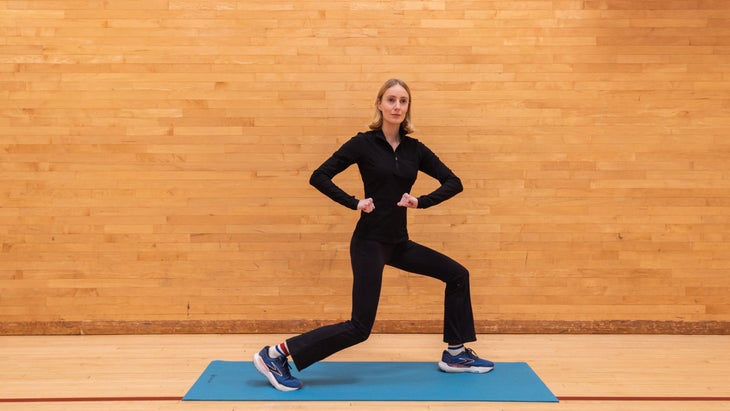
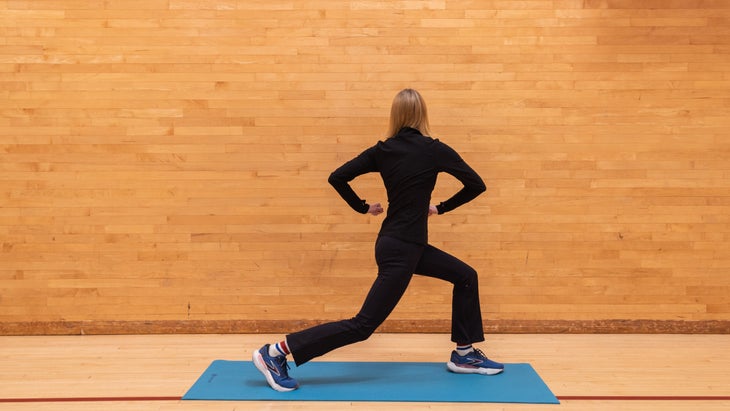
Dynamic: Lunge with Rotation
Stand with your feet hip-width apart. Take a big step forward with one foot, and bend both knees as you drop into a lunge. Your knees should both be at 90-degree angles and your back knee should be hovering just slightly above the ground. Bend your elbows at your sides and twist your torso across your front leg, then across your back leg, then back to center. That’s one rep. Come back to standing and repeat on the opposite leg. Perform 10 reps on each side.
You should feel this movement primarily in the quad of your front leg. If not, hinge your torso just slightly forward to bring more weight into your front leg.
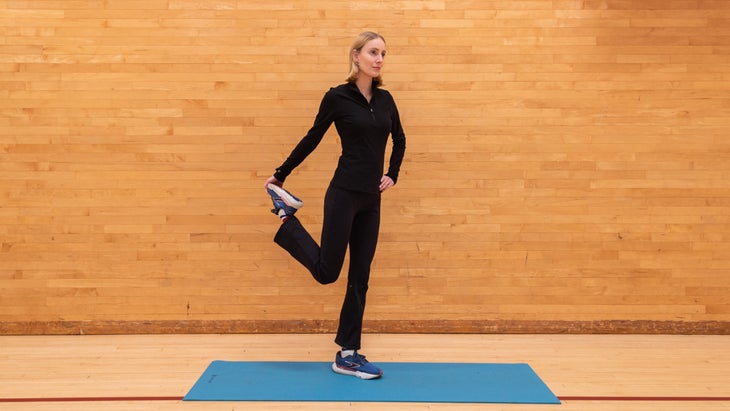
Static: Standing Quad Stretch
You can do this move free-standing or with one hand gently pressed against a wall or lightly holding a chair for balance. Standing with feet parallel, bend your right leg, bringing your foot behind you. Reach back with your right hand and grab hold of the top of your foot. Gently pull upwards on your foot, feeling the stretch in your quad. Hold for 30 to 60 seconds before switching sides.
Hamstrings
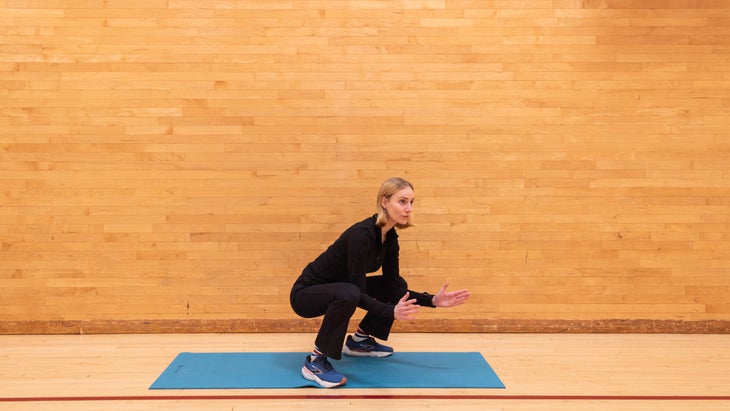
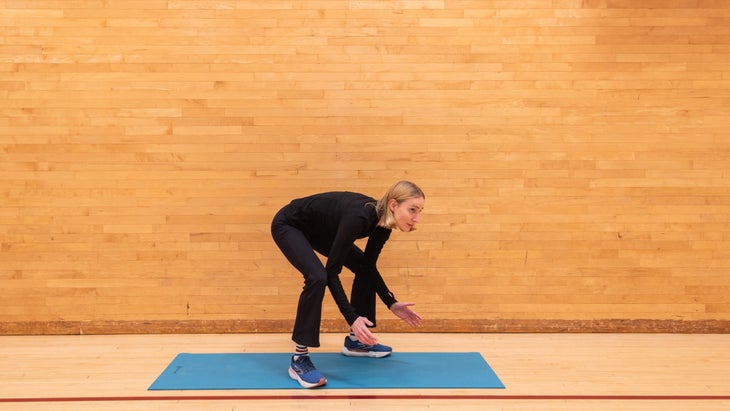
Dynamic: Hamstring Stretch
Stand with feet hip-width apart and a slight bend in the knees. Hinge at the hips and lower your arms and torso towards the floor, keeping your legs straight enough to feel a good stretch in your hamstrings. Once your hands touch the ground, lower your hips into a deep squat. From there, raise the hips without lifting the torso (try to keep your fingertips in contact with the floor). Lower right back down into the deep squat. Continue this motion of raising and lowering the hips for ten reps.
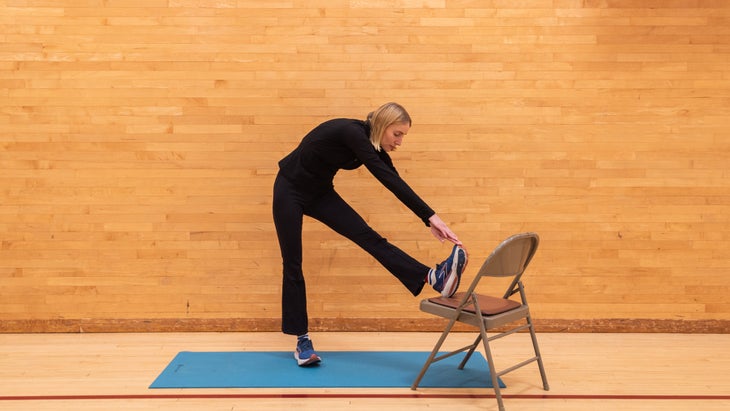
Static: Elevated Leg Stretch
Standing with feet parallel in front of a chair, couch, or bench, lift one leg and place your heel on the elevated surface. Keeping a soft bend in your standing leg and your lifted leg straight, reach your hands towards the foot of your lifted leg and hold for 30 to 60 seconds. You should feel a gentle stretch in the back of the lifted leg.
Hips
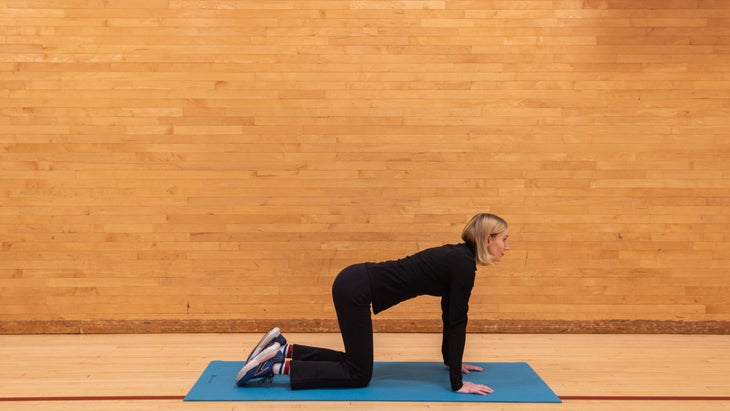
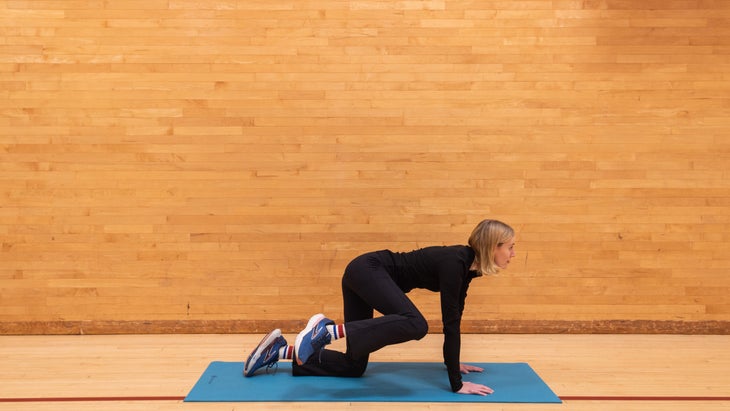
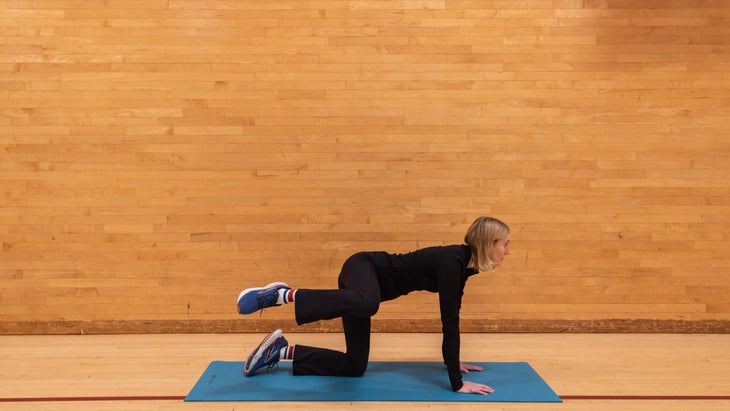
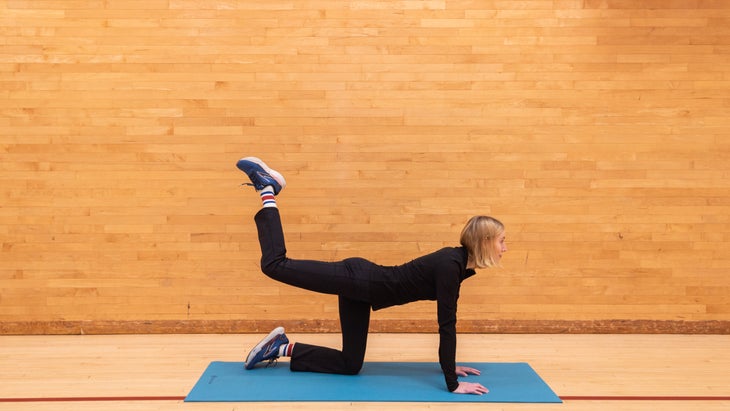
Dynamic: Hip CARs (Controlled Articular Rotations)
Begin on all fours. Keeping your torso centered and stable and without collapsing to one side, lift your bent right leg and draw the knee in towards your right elbow, then out to the side, then back, ending with your leg behind you, knee bent and heel pointed towards the ceiling. Bring the knee back to the ground to complete the motion. Then reverse it. You should feel this movement in your hip flexors and glutes, and it should feel like you’re rotating your leg through the entire range of motion of your hip joint. That’s one rep. Complete ten reps.
Note: You can also do this move standing if being on your knees is uncomfortable. You can gently hold onto a static object to help with balance.
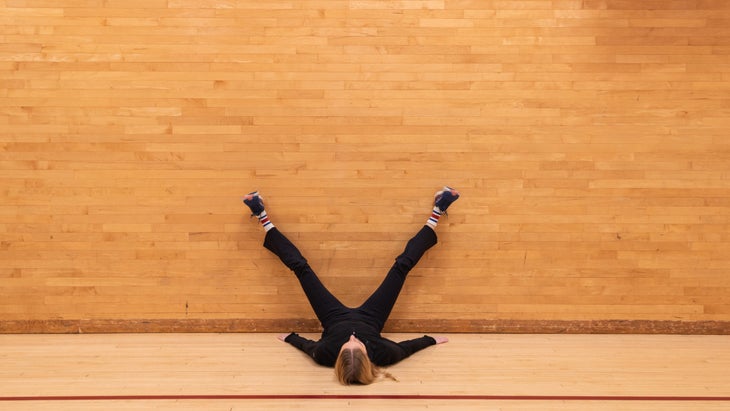
Static: Wall V-Stretch
Lying on your back with your butt and legs pressed up against a wall, open your legs into a wide V position. You can gently press out on your inner thighs with your hands to deepen the stretch. Hold for 30 to 60 seconds.
You should feel a stretch in your inner thighs and hip flexors.
Shoulders
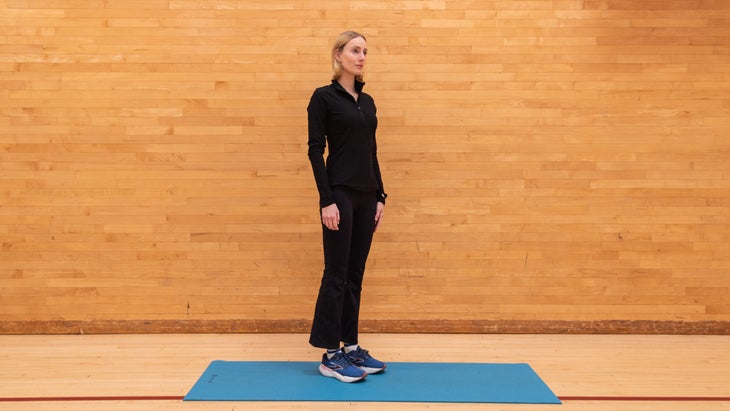

Dynamic: Shoulder Rolls
With your arms by your sides or outstretched, draw your shoulders up towards your ears, then down your back, feeling your shoulder blades rise and lower. After doing 10 reps backward, switch directions for 10 reps forward. Lastly, raise your arms overhead and draw your shoulders up, then release them back down. You should feel this in the front and back of your shoulders (anterior and rear delts) and your lats. Perform 10 reps overhead.
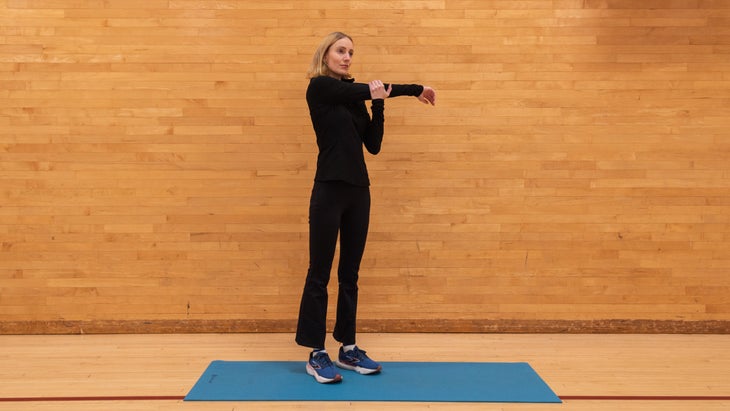
Static: Cross-Body Shoulder Stretch
Begin with your arms hanging by your sides. Raise and reach your right arm across your chest. Grasp your upper right arm just above the elbow with your left hand and gently pull your arm to deepen the stretch. Hold for 30 to 60 seconds.
You should feel this in the back of your shoulders and lats.
Core and Spine
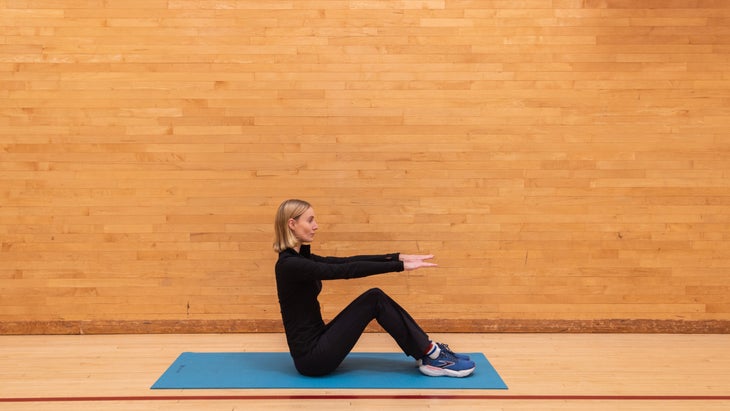

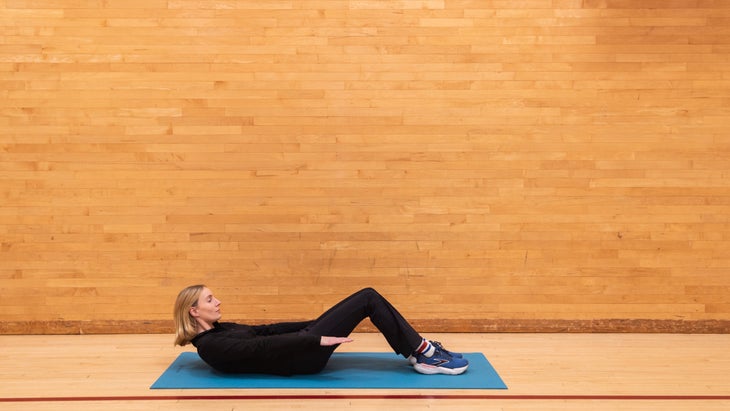
Dynamic: Roll-Down and Roll-Up
Begin in a seated position with your knees bent and feet flat on the floor. Your legs should be hip-width apart. Extend your arms in front of you. Begin to slowly roll your torso down towards the mat, keeping your core braced as you go, controlling through the entire range of motion. Once you reach the mat, inhale, exhale, and begin to slowly roll back up. That’s one rep. Complete ten reps.
This move should gently challenge your core stability and warm up the muscles that surround your spine. If you feel a strain or discomfort in your lower back, shorten your range of motion; instead of lowering all the way to the mat, stop about halfway down and then roll back up.
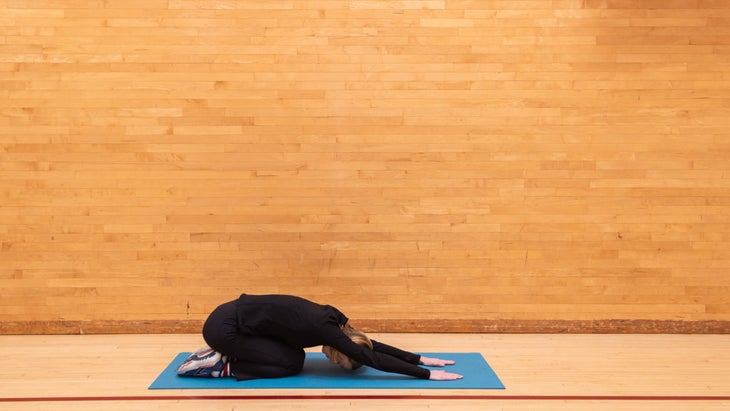
Static: Child’s Pose and Shell Stretch
Begin on the floor in a kneeling position. Bring your knees wide and your toes together, and sit your butt back on your heels. Walk your hands out in front of you until you’re folded forward at the hips. Maintain a neutral neck position, with your eyes looking at the floor directly beneath your head. Tilt your tailbone back towards your heels. Hold that stretch. Then reach your hands forward and let your tailbone rock forward. Hold that position. Repeat, shifting your tailbone back and forth with a hold at each end range, for 30 to 60 seconds.
